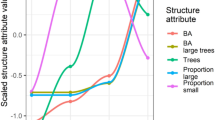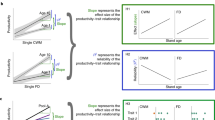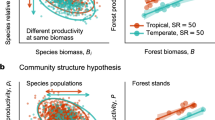Abstract
Tropical forests are converted at an alarming rate for agricultural use and pastureland, but also regrow naturally through secondary succession. For successful forest restoration, it is essential to understand the mechanisms of secondary succession. These mechanisms may vary across forest types, but analyses across broad spatial scales are lacking. Here, we analyse forest recovery using 1,403 plots that differ in age since agricultural abandonment from 50 sites across the Neotropics. We analyse changes in community composition using species-specific stem wood density (WD), which is a key trait for plant growth, survival and forest carbon storage. In wet forest, succession proceeds from low towards high community WD (acquisitive towards conservative trait values), in line with standard successional theory. However, in dry forest, succession proceeds from high towards low community WD (conservative towards acquisitive trait values), probably because high WD reflects drought tolerance in harsh early successional environments. Dry season intensity drives WD recovery by influencing the start and trajectory of succession, resulting in convergence of the community WD over time as vegetation cover builds up. These ecological insights can be used to improve species selection for reforestation. Reforestation species selected to establish a first protective canopy layer should, among other criteria, ideally have a similar WD to the early successional communities that dominate under the prevailing macroclimatic conditions.
This is a preview of subscription content, access via your institution
Access options
Access Nature and 54 other Nature Portfolio journals
Get Nature+, our best-value online-access subscription
$29.99 / 30 days
cancel any time
Subscribe to this journal
Receive 12 digital issues and online access to articles
$119.00 per year
only $9.92 per issue
Buy this article
- Purchase on Springer Link
- Instant access to full article PDF
Prices may be subject to local taxes which are calculated during checkout


Similar content being viewed by others
Data availability
The dataset on CWM WD values and WD ranges for the plots from 49 sites (Fig. 1) is available from the Data Archiving and Networked Services repository at https://doi.org/10.17026/dans-z3s-3d7t. For one other site, data are available on request. The data used to produce Fig. 2 can be found in Supplementary Table 1.
References
Shipley, B., Vile, D. & Garnier, É. From plant traits to plant communities: a statistical mechanistic approach to biodiversity. Science 314, 812–814 (2006).
Clements, F. E. Plant Succession: an Analysis of the Development of Vegetation (Carnegie Institution of Washington, 1916).
Bazzaz, F. A. Physiological ecology of plant succession. Annu. Rev. Ecol. Syst. 10, 351–371 (1979).
Wright, I. J. et al. The worldwide leaf economics spectrum. Nature 428, 821–827 (2004).
Pianka, E. On r and K selection. Am. Nat. 104, 592–597 (1970).
Tilman, D. Plant Strategies and the Dynamics and Structure of Plant Communities (Princeton Univ. Press, 1988).
Kitajima, K. Relative importance of photosynthetic traits and allocation patterns as correlates of seedling shade tolerance of 13 tropical trees. Oecologia 98, 419–428 (1994).
Finegan, B. Pattern and process in Neotropical secondary rain forests: the first 100 years of succession. Trends Ecol. Evol. 11, 119–124 (1996).
Chazdon, R. L. Second Growth: The Promise of Tropical Forest Regeneration in an Age of Deforestation (Univ. Chicago Press, 2014).
Peterson, C. & Carson, W. in Tropical Forest Community Ecology 367–383 (Wiley-Blackwell, 2008).
Lohbeck, M. et al. Successional changes in functional composition contrast for dry and wet tropical forest. Ecology 94, 1211–1216 (2013).
Santiago, L. et al. Leaf photosynthetic traits scale with hydraulic conductivity and wood density in Panamanian forest canopy trees. Oecologia 140, 543–550 (2004).
Poorter, L. et al. The importance of wood traits and hydraulic conductance for the performance and life history strategies of 42 rainforest tree species. New Phytol. 185, 481–492 (2010).
Pineda-García, F., Paz, H. & Meinzer, F. C. Drought resistance in early and late secondary successional species from a tropical dry forest: the interplay between xylem resistance to embolism, sapwood water storage and leaf shedding. Plant Cell Environ. 36, 405–418 (2013).
Van Gelder, H. A., Poorter, L. & Sterck, F. J. Wood mechanics, allometry, and life-history variation in a tropical rain forest tree community. New Phytol. 171, 367–378 (2006).
Loehle, C. Tree life history strategies: the role of defenses. Can. J. For. Res. 18, 209–222 (1988).
Díaz, S. et al. The global spectrum of plant form and function. Nature 529, 167–171 (2016).
Chave, J. et al. Towards a worldwide wood economics spectrum. Ecol. Lett. 12, 351–366 (2009).
Norden, N. et al. Successional dynamics in Neotropical forests are as uncertain as they are predictable. Proc. Natl Acad. Sci. USA 112, 8013–8018 (2015).
Markesteijn, L., Poorter, L., Paz, H., Sack, L. & Bongers, F. Ecological differentiation in xylem cavitation resistance is associated with stem and leaf structural traits. Plant Cell Environ. 34, 137–148 (2011).
Brando, P. M. et al. Fire-induced tree mortality in a Neotropical forest: the roles of bark traits, tree size, wood density and fire behavior. Glob. Change Biol. 18, 630–641 (2012).
Vieira, D. L. & Scariot, A. Principles of natural regeneration of tropical dry forests for restoration. Restor. Ecol. 14, 11–20 (2006).
Poorter, L. et al. Resprouting as a persistence strategy of tropical forest trees: relations with carbohydrate storage and shade tolerance. Ecology 91, 2613–2627 (2010).
Lebrija-Trejos, E., Meave, J. A., Poorter, L., Pérez-García, E. A. & Bongers, F. Pathways, mechanisms and predictability of vegetation change during tropical dry forest succession. Pers. Plant Ecol. Evol. Syst. 12, 267–275 (2010).
Lebrija-Trejos, E., Pérez-García, E. A., Meave, J. A., Poorter, L. & Bongers, F. Environmental changes during secondary succession in a tropical dry forest in Mexico. J. Trop. Ecol. 27, 477–489 (2011).
Poorter, L. et al. Biomass resilience of Neotropical secondary forests. Nature 530, 211–214 (2016).
Fyllas, N. M. et al. Basin-wide variations in foliar properties of Amazonian forest: phylogeny, soils and climate. Biogeosciences 6, 2677–2708 (2009).
Chase, J. M. Drought mediates the importance of stochastic community assembly. Proc. Natl Acad. Sci. USA 104, 17430–17434 (2007).
Fukami, T. Historical contingency in community assembly: integrating niches, species pools, and priority effects. Annu. Rev. Ecol. Evol. Syst. 46, 1–23 (2015).
Finegan, B. et al. Does functional trait diversity predict above‐ground biomass and productivity of tropical forests? Testing three alternative hypotheses. J. Ecol. 103, 191–201 (2015).
Cornwell, W. K. et al. Plant species traits are the predominant control on litter decomposition rates within biomes worldwide. Ecol. Lett. 11, 1065–1071 (2008).
Sande, M. T. et al. Biodiversity in species, traits, and structure determines carbon stocks and uptake in tropical forests. Biotropica 49, 593–603 (2017).
Sakschewski, B. et al. Resilience of Amazon forests emerges from plant trait diversity. Nat. Clim. Change 6, 1032–1036 (2016).
Holl, K. D. Restoring tropical forests from the bottom up. Science 355, 455–456 (2017).
Rozendaal, D. M. A. et al. Biodiversity recovery of Neotropical secondary forests. Sci. Adv. 5, eaau3114 (2019).
Chazdon, R. L. et al. Carbon sequestration potential of second-growth forest regeneration in the Latin American tropics. Sci. Adv. 2, e1501639 (2016).
Van Breugel, M., Bongers, F. & Martínez-Ramos, M. Species dynamics during early secondary forest succession: recruitment, mortality and species turnover. Biotropica 39, 610–619 (2007).
Gei, M. et al. Legume abundance along successional and rainfall gradients in Neotropical forests. Nat. Ecol. Evol. 2, 1104–1111 (2018).
Connell, J. H. & Slatyer, R. O. Mechanisms of succession in natural communities and their role in community stability and organization. Am. Nat. 111, 1119–1144 (1977).
Chazdon, R. L. Beyond deforestation: restoring forests and ecosystem services on degraded lands. Science 320, 1458–1460 (2008).
Quesada, M. et al. Succession and management of tropical dry forests in the Americas: review and new perspectives. For. Ecol. Manag. 258, 1014–1024 (2009).
Gómez-Aparicio, L. et al. Applying plant facilitation to forest restoration: a meta‐analysis of the use of shrubs as nurse plants. Ecol. Appl. 14, 1128–1138 (2004).
Padilla, F. M. & Pugnaire, F. I. The role of nurse plants in the restoration of degraded environments. Front. Ecol. Environ. 4, 196–202 (2006).
Reich, P. B. The world-wide ‘fast–slow' plant economics spectrum: a traits manifesto. J. Ecol. 102, 275–301 (2014).
Baraloto, C. et al. Decoupled leaf and stem economics in rain forest trees. Ecol. Lett. 13, 1338–1347 (2010).
Lambers, H. & Poorter, H. Inherent variation in growth rate between higher plants: a search for physiological causes and ecological consequences. Adv. Ecol. Res. 23, 187–261 (1992).
Pérez-Harguindeguy, N. et al. New handbook for standardised measurement of plant functional traits worldwide. Aus. J. Bot. 61, 167–234 (2013).
Zanne, A. E. et al. Data from: Towards a Worldwide Wood Economics Spectrum (Dryad Digital Repository, 2009); https://doi.org/10.5061/dryad.234
Coelho de Souza, F. et al. Evolutionary heritage influences Amazon tree ecology. Proc. R. Soc. B 283, 20161587 (2016).
Thomas, S. C. Asymptotic height as a predictor of growth and allometric characteristics in Malaysian rain forest trees. Am. J. Bot. 83, 556–566 (1996).
Ter Steege, H. et al. Continental-scale patterns of canopy tree composition and function across Amazonia. Nature 443, 444–447 (2006).
Hengl, T. et al. SoilGrids250m: global gridded soil information based on machine learning. PLoS ONE 12, e0169748 (2017).
Laliberté, E., Legendre, P. & Shipley, B. FD: Measuring functional diversity from multiple traits, and other tools for functional ecology. R package version 1.0-12 (2014).
Acknowledgements
This paper is a product of the 2ndFOR collaborative research network on secondary forests (www.2ndfor.org). We thank the owners of the secondary forest sites and local communities for access to their forests, everyone who established and measured the plots, and the institutions and funding agencies that supported them. We thank the following agencies for financial support: the Netherlands Organisation for Scientific research (NWO-ALW.OP241 and NWO-ALW 863.15.017), Wageningen University and Research (INREF FOREFRONT and Terra Preta programmes, and the Strategic Investment Programme Resilience), a Macquarie University Visiting Researcher grant to L.P., the Biological Dynamics of Forest Fragments Project, CIFOR, COLCIENCIAS grant 1243-13-16640, CONACYT PhD grant 169510, Conselho Nacional de Desenvolvimento Científico e Tecnológico (grant numbers 481576/2009-6, 304817/2015-5, 309874/2015-7, 306375/2016-8 and 308471/2017-2), Coordenação de Aperfeiçoamento de Pessoal de Nível Superior (grant number 88881.064976/2014-01), the German Academic Exchange Service, FAPEMIG, the Garden Club of America Award in Tropical Botany, the Global Environment Facility (grant VEN/SGP/2010-2015), ICETEX, Instituto Nacional de Investigaciones Agrícolas, Instituto Nacional de Ciência e Tecnologia dos Serviços Ambientais da Amazônia, the International Climate Initiative of the German Federal Ministry for the Environment, Nature Conservation, Building and Nuclear Safety, the Lewis and Clark Fund for Exploration and Field Research, NASA ROSES grant NNH08ZDA001N-TE, the Norwegian Agency for Development Cooperation, NUFFIC, Yale-NUS College (grant R-607-265-054-121), FOMIX-Yucatan (YUC-2008-C06-108863), OTS and the Christiane and Christopher Tyson Fellowship, PAPIIT-UNAM (218416 and 211114), the Ronald Bamford Endowment, the São Paulo Research Foundation (grant numbers 2011/06782-5 and 2014/14503-7), SENACYT grant COL10-052, SEP-CONACYT (CB-2009-128136 and CB 2015- 255544), Stichting Het Kronendak, Tropenbos International, the United Nations Development Program (Venezuela) and the US National Science Foundation (DEB-0639114, DEB-1147434, DEB-0424767, DEB-0639393, DEB-1147429, DEB- 1110722, NSF-0946618 and NSF-9208031). This is publication number 752 in the Technical Series of the Biological Dynamics of Forest Fragments Project BDFFP-INPA-SI and publication number 5 from 2ndFOR.
Author information
Authors and Affiliations
Contributions
L.P. and M.W. conceived the idea. L.P. and D.M.A.R. coordinated the data compilations. D.M.A.R. carried out the data analysis. L.P., D.M.A.R., F.B. and M.W. contributed to the analytical tools used in the analysis. E.N.B. and A.M.A.Z. made the map. L.P. wrote the paper. All co-authors collected field data, discussed the results, suggested further analyses and commented on the manuscript.
Corresponding author
Ethics declarations
Competing interests
The authors declare no competing interests.
Additional information
Publisher’s note: Springer Nature remains neutral with regard to jurisdictional claims in published maps and institutional affiliations.
Supplementary information
Supplementary Information
Supplementary Figures, Tables, References and Notes
Rights and permissions
About this article
Cite this article
Poorter, L., Rozendaal, D.M.A., Bongers, F. et al. Wet and dry tropical forests show opposite successional pathways in wood density but converge over time. Nat Ecol Evol 3, 928–934 (2019). https://doi.org/10.1038/s41559-019-0882-6
Received:
Accepted:
Published:
Issue Date:
DOI: https://doi.org/10.1038/s41559-019-0882-6
This article is cited by
-
Functional Traits Drive the Selection of Plant Species Used by Agropastoralists in the Brazilian Semiarid Region
Economic Botany (2024)
-
Divergent hydraulic strategies of two deciduous tree species to deal with drought in the Brazilian semi-arid region
Trees (2024)
-
The carbon sink of secondary and degraded humid tropical forests
Nature (2023)
-
Quantifying functional trait assembly along a temperate successional gradient with consideration of intraspecific variations and functional groups
Plant Ecology (2023)
-
Intraspecific trait variation and species turnover in successional tropical forests: assessing trait imputation for community-weighted means
Plant Ecology (2023)



